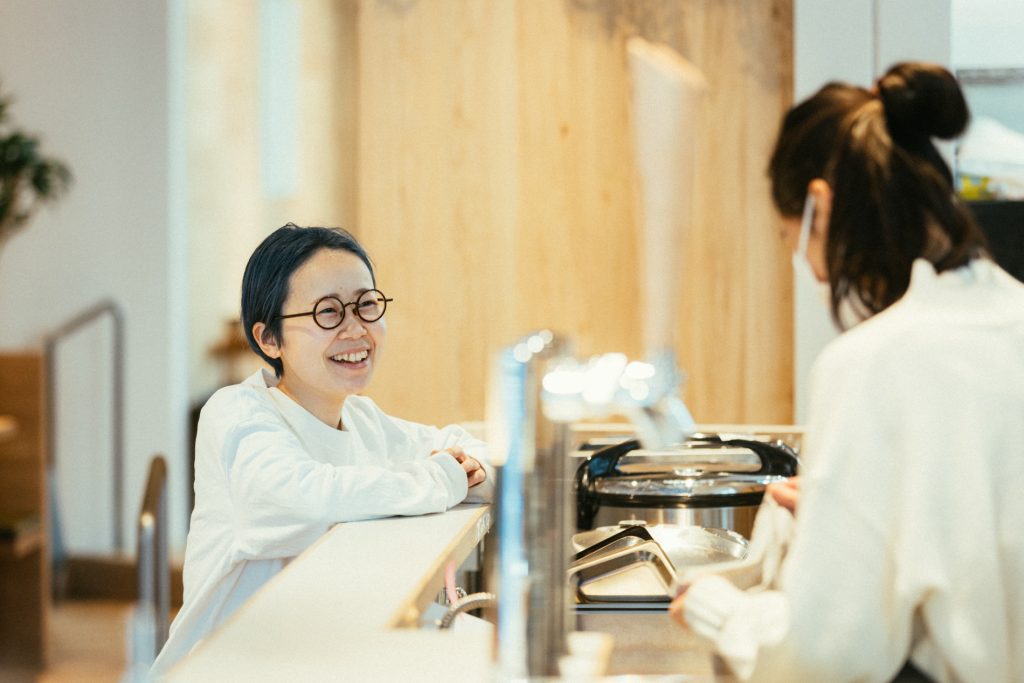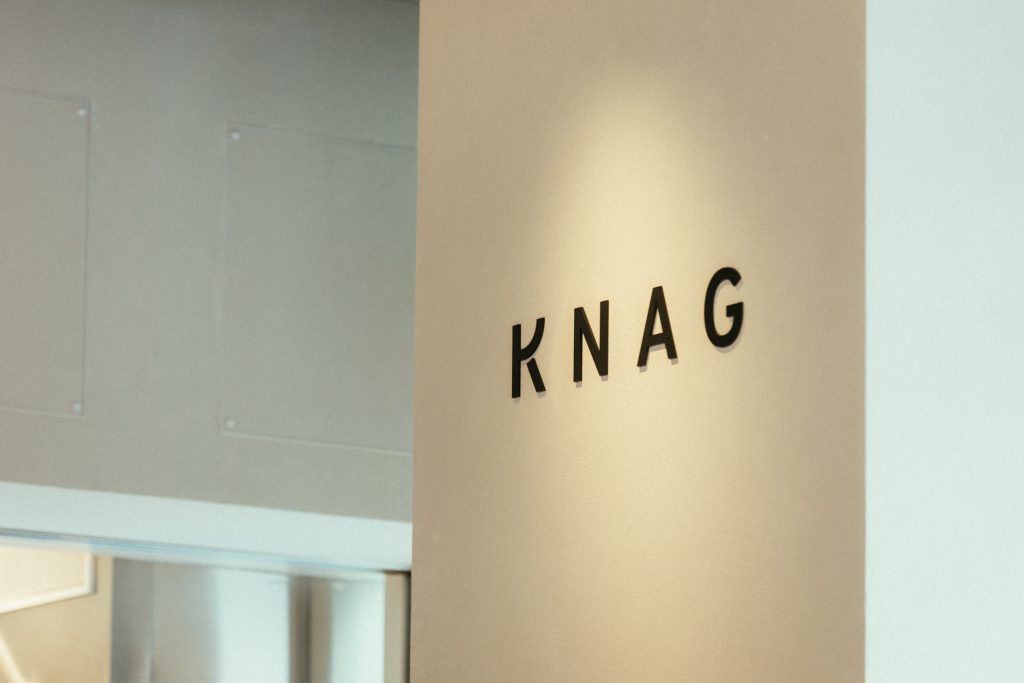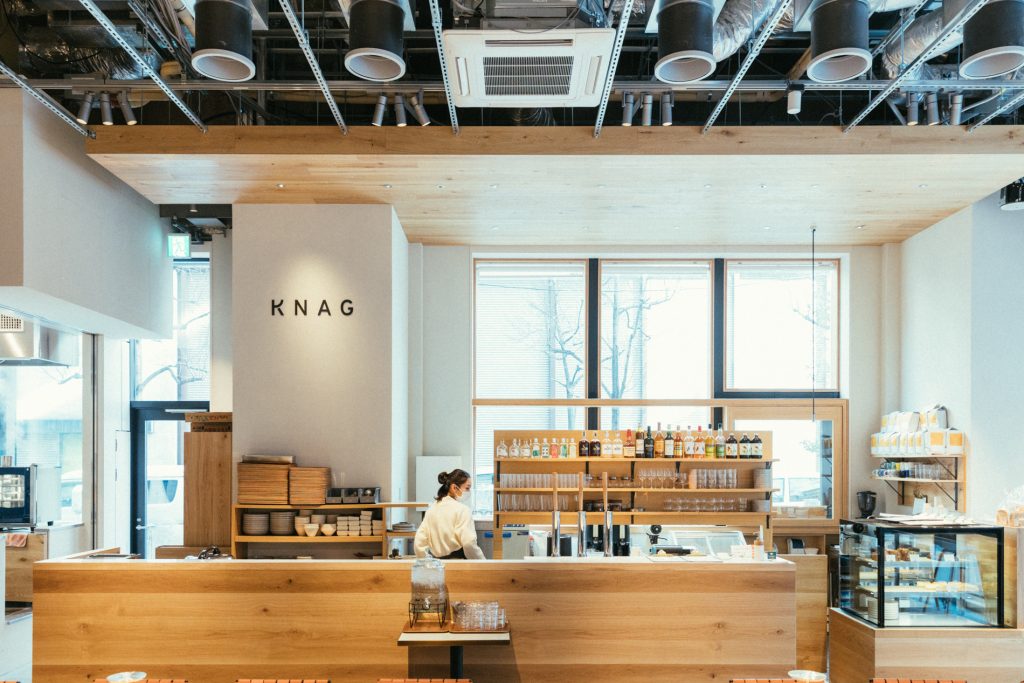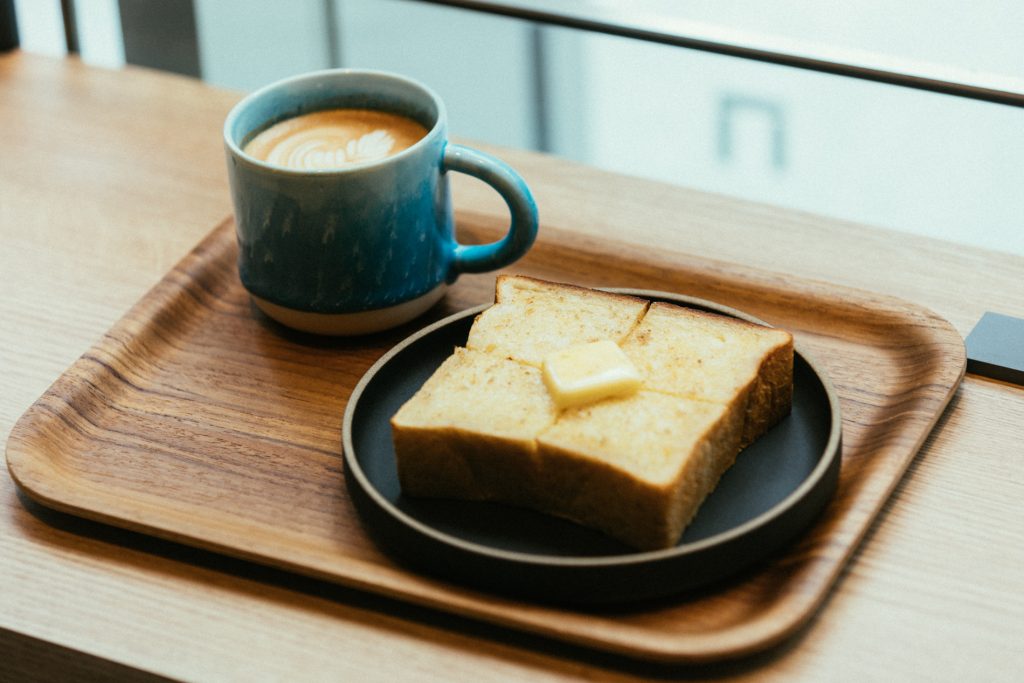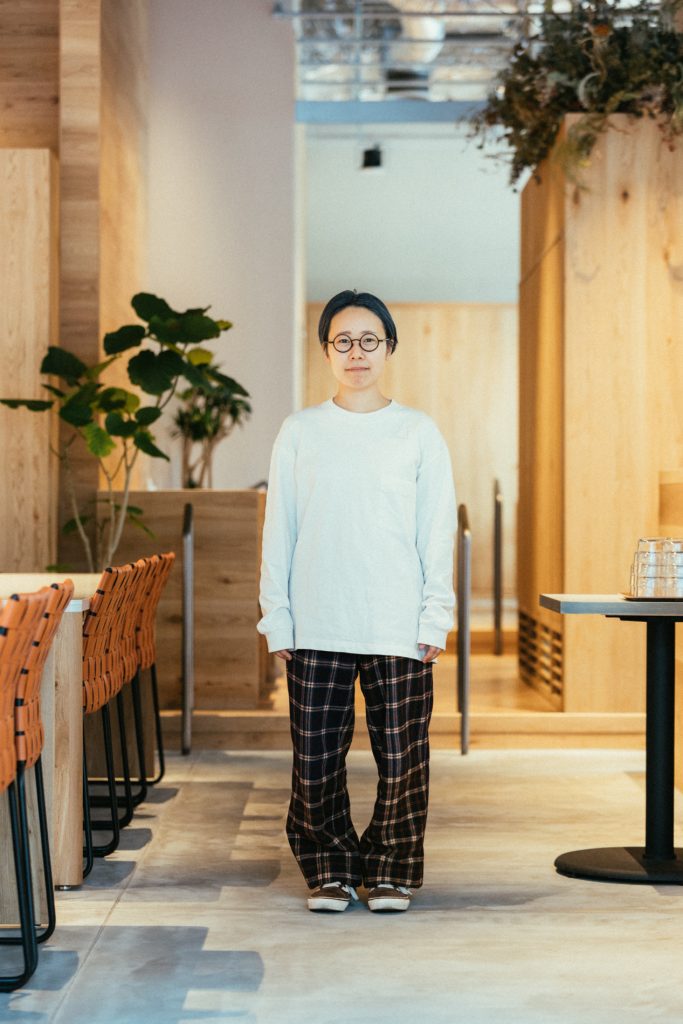


KNIT TOGETHER
A comfortable space for neighbors to be together
●Where are you from?
I’m from Oita Prefecture in Kyushu.
● What was your school experience like?
I was rarely involved in club activities, so I spent most of my time in the library. I was a shallow, yet broad type of person, so I remember envying my friends who were devoted to their hobbies.
●What did you do after high school?
I was interested in clothing, so I entered Bunka Fashion College.
●Was there a reason why you became interested in fashion? For example, did you come across a nice select store?
I was living in Kunitachi, a rural town, and although there was an airport in Oita, there weren’t really any nice stores around……. It was around that time that secondhand clothing began gaining popularity in Japan, but to be honest I was interested in fashion because I didn’t really have access to it. There was really only the ocean and the mountains.
●Was Tokyo on your radar at all?
Not really. I mean, I lived in Tokyo until I went to elementary school. I don’t remember that much about it, but I always kind of had the feeling that I was there. That’s maybe why I didn’t really have that much of a yearning for it.
●What was life like in college?
I did some serious studying! I was in the now-defunct ‘Stylist Department’, where we did sketches and made clothes. It was not so focussed, more of a broad and shallow approach to study. But there were a lot of assignments I had to get through, so the two years flew by! I probably should have had more fun rather than just studying all the time.
●The scope of your studies sounds broad. Were there any areas that you found particularly interesting?
We had an assignment on children’s clothing once, and that piqued my interest. I even ended up working part-time at a children’s clothing store.
●What made you pursue children’s clothing?
Children’s clothes are very elaborate and cute. Also, I was interested in the slightly larger sizes because I could wear them myself.
●Gap Kids T-shirts are really cute, aren’t they?
Yeah, they are! I started out as a part-timer, but then became a full-time employee of a select store that specialized in domestic children’s clothing brands. I was involved in sales for about four years there.
●What kind of people worked there?
There were a lot of people my age who liked clothes, and it was fun making friends with them. But the longer I stayed, the more I realized that the nature of the company didn’t suit me very well, and everyone gradually quit……. So I decided to leave the company too and became a freelancer.
●It’s a bold move, entering the next phase, but not knowing what’s next.
I’m the type of person who can’t move forward without a goal, so I wanted to create a goal somehow. After I quit I decided to go to Finland. It was something I had always dreamed of. Once I had decided to go, my outlook became more positive, and I worked part-time for a year to save up money and start my first trip abroad.
●Why Finland?
I love the products from Finland. I really wanted to visit a flea market there.
●Wasn’t it nerve-wracking to travel abroad for the first time to a country where English is not the first language?
I just wanted to go there so badly that I didn’t think anything of it. I thought I would be able to make it if I went!
●Are there any places that left a lasting impression on you?
I don’t remember where it was, but there was a flea market in a really big warehouse that was really nice. There was a huge selection of old clothes, furniture, and antiques. I managed to finish my week-long trip safely.
●What did you do when you returned home?
Since I had achieved one goal, I thought about what to do next, but in the end, my love for clothes remained unchanged. And since I had experience selling items online I began to search for companies using the keywords “apparel” and “mail-order”. From there I joined a company that dealt in second-hand brand clothes.
● It may be commonplace nowadays, but I remember back then that second hand branded clothing was new to me.
At first, I wasn’t that interested in brand-name clothes, but it was refreshing to see clothes that had been sitting at home being passed on to people who needed them, and it was interesting to see the variety of clothes. I ended up working there for nine years, and my experience there led me to my current company, WAT Inc. (※1)
※1 WAT Inc.
A company that brings people together through the operation of cafes, to create communities through connection and liveliness.
●What was the experience like?
At the end of the nine years, I was working in a department that was responsible for internal training. I began thinking about employee development and how to create and implement it in a given location. I think the keyword “community” stood out to me.
●Have you noticed any significant changes in yourself since then?
I joined the company in its third to fourth term as a venture capitalist when the president and employees were still working together in the same space. The president was very passionate about education and so we were working together to formulate a curriculum based on the president’s educational methods. I felt a good balance between the right and left sides of my brain, which helped me to arrive at the keywords of ‘place-making’ and ‘community’. That’s what made me join WAT Inc. in 2020 and led me to become in charge of KNAG and another cafe in the office of a company.
●What exactly does it mean to balance the right and left sides of your brain?
I guess I mean the balance between the hardness of numbers and the flexibility of ideas. But even in this idea of hardness, there was a sense of humanity. There were many times when I felt mentally exhausted, but I was able to overcome it because I felt that my colleagues really cared about my wellbeing. They helped me develop the ability to think positively and move forward.
●Please tell us about your role in KNAG.
At WAT Inc. I work in a team that focuses on community building, and through events and other activities, we are trying to create a place where cafes can become a hub for the local community.
I envision the café becoming the hub of Kabutocho, creating a situation where people can gather and create a variety of connections.
●Did Covid make it difficult to create the kind of place you originally had in mind?
It was very hap-hazardous. I couldn’t see what was going to happen with Covid, so I could only steer the ship by adjusting the course and stretching what I could at the time while facing the present. But looking back, I can honestly say that I managed to handle the situation. But on the other hand, because of Covid, we have seen the real need for community, and I feel that it has been easier to be active.
●Please tell us about the concept of KNAG.
The overall concept is to “enrich the expression of Kabutocho,” including food and beverage, but for the community part, we have two keywords: “place” and “emergence”. Then, I envision the café becoming the hub of Kabutocho, creating a situation where people can gather and create a variety of connections.
●I think there are many ways to communicate nowadays, especially with the development of social media, but communication is not only what’s on the screen. This is what makes drinking a cup of coffee an experience. I feel that the use of time, such as with whom and where, is in demand, and this has become even more so due to the pandemic.
Whether it’s between customers or between customers and staff, this place has triggered conversations and communication, and I really feel that this sense of connection is now more in demand. The other day, I planned a happy hour event based on the concept of ‘communication in 15 minutes’. It was very well-received. We served alcohol for 100 yen and encouraged people to communicate for 15 minutes. It made it possible to turn a time that people usually spend on the way home into a time for people to connect.
● What kind of people came?
There were people who work nearby, others who were visiting the shop for the first time, and some who happened to drop by on their way home from work. It expanded as they brought their colleagues the next day, and people of all ages, both men and women. I planned this event with the hope that the day would be enriched by the 15 minutes of conversations that might not have taken place otherwise.
●Do you have your own vision of what a café should be?
This may be a personal opinion, but I believe that cafes and the community are inseparable. I believe that people come to cafes not only to eat and drink but also to make connections. I want the staff working at the restaurant to be thinking in the same way. Although my job title is that of community builder, it is the staff working there who actually meet and communicate with the customers. So, to put it another way, as long as the staff has a community builder mindset, they don’t need me. Ideally, I would like to be able to look after only the necessary aspects.
The name "KNAG" means "coat hanging" in Danish.
●In Tokyo, I think that it’s difficult to have a favorite café. My impression is that most of us consume coffee in-between our busy schedules. But in café culture overseas, there is a feeling that a customer is not just a customer. I think it gives you more freedom, to get to know them better and even learn their preferences. Just witnessing such a scene from the outside is very comfortable, and just being able to be in such a space makes you feel happy.
That’s right. For me, a cafe is a place where you are accepted as a human being and can make it your own space.
●Depending on the time of day and purpose, I think the customer’s needs can change. Do you adapt your menu depending on the time of day?
In the mornings, there is a lot of demand for take-out before work, so coffee and sandwiches make up most of the sales. But for lunchtime, we have deli items and salads that can be prepared quickly. At teatime, we have a wide selection of cakes and other sweets as well as a wide range of drinks. Many of our neighbors with children also use our teatime service. For dinner, we have a wide selection of craft beers and natural wines, and our deli and fried chicken with original spices are popular.
●Oh, so many locals are visiting too?
At first, we thought there would be a lot of businessmen and other workers, but we were surprised to find that there were a lot of families living nearby. We can see the kids of those families developing and growing, so we’re really looking forward to growing together with this neighborhood.
●It’s been a month since the cafe opened, how do you hope word of the cafe will spread in the future?
I really like the idea of getting to know more people coming to the cafe. Naturally, it’s great when people share through social media like Instagram, but I think it’s even better when people spread through word of mouth. The name “KNAG” means “coat hanging” in Danish, and I hope that it will become a space where everyone can casually take off their coats and relax their shoulders.
Each customer uses the space with a sense of comfort, and this accumulates to form a space that is easy for everyone to use.
●What type of places do you like to visit?
I like going out to drink, so I often visit bars, with my favorite being a standing-only skewer shop called Tenshichi in Kita-senju. It’s a counter bar/restaurant, and there are people of all ages, men, and women, huddled around it. In a way, it’s a microcosm of the city. I really like the atmosphere and the situation where you can start a conversation with someone you happen to be standing next to. In other words, the food is not that important, but I want to experience is the feeling of being part of the community. Here at KNAG, I hope to create a situation where people can come here and find a connection with someone, even if it is unintentional.
●Places that naturally possess this kind of atmosphere will surely draw people from overseas, right? You can tell at a glance what the city is like and what color it has.
A space full of hospitality that welcomes you is actually not created with much conscious thought. Each customer uses the space with a sense of comfort, and this accumulates to form a space that is easy for everyone to use. I feel that this atmosphere has created a space where even foreigners feel welcomed.
●In that sense, by having customers come in with the nuance of participating in the community, it feels that the café space will be transformed into another comfortable space.
Create a space that both customers and staff feel comfortable in. I believe that a space should not lack either of these elements. I think it is my role as a generalist and community builder to create an environment where the specialists and the staff who greet the customers, can communicate well.

Miki Yoshitake
Born in Oita Prefecture in 1986. She spent her school days in Oita, where the sea and mountains lie surrounded by nature. Interested in apparel, she moved to Tokyo to enter Bunka Fashion College. After working in the styling department, she started working at a children’s clothing store, and as her interest shifted to online sales, she gained experience at an e-commerce store that specializes in second-hand brand clothes. After being involved in employee training, she became interested in community building and joined WAT Inc. in 2020. As a community builder, she is currently involved in the creation of spaces at KNAG in Kabutocho and cafes in corporate offices.
Text : Jun Kuramoto
Photo : Naoto Date
Interview : Jun Kuramoto
Miki Yoshitake
KNAG Community Builder
The wife of the head of the neighborhood association. Owner of Coffee shop Yuu
Interesting people in Kabutocho
The wife of the head of the neighborhood association.
I would like to hear from the wife of the head of the neighborhood association about the changes she has seen while living in Kabutocho, the trajectory of those changes, and her role behind the scenes.
Owner of Coffee shop Yuu
A friend of mine, who loves to visit cafes, told me that he was surprised to see the amount of money spent on business negotiations by businessmen sitting in old classic coffee shops.
